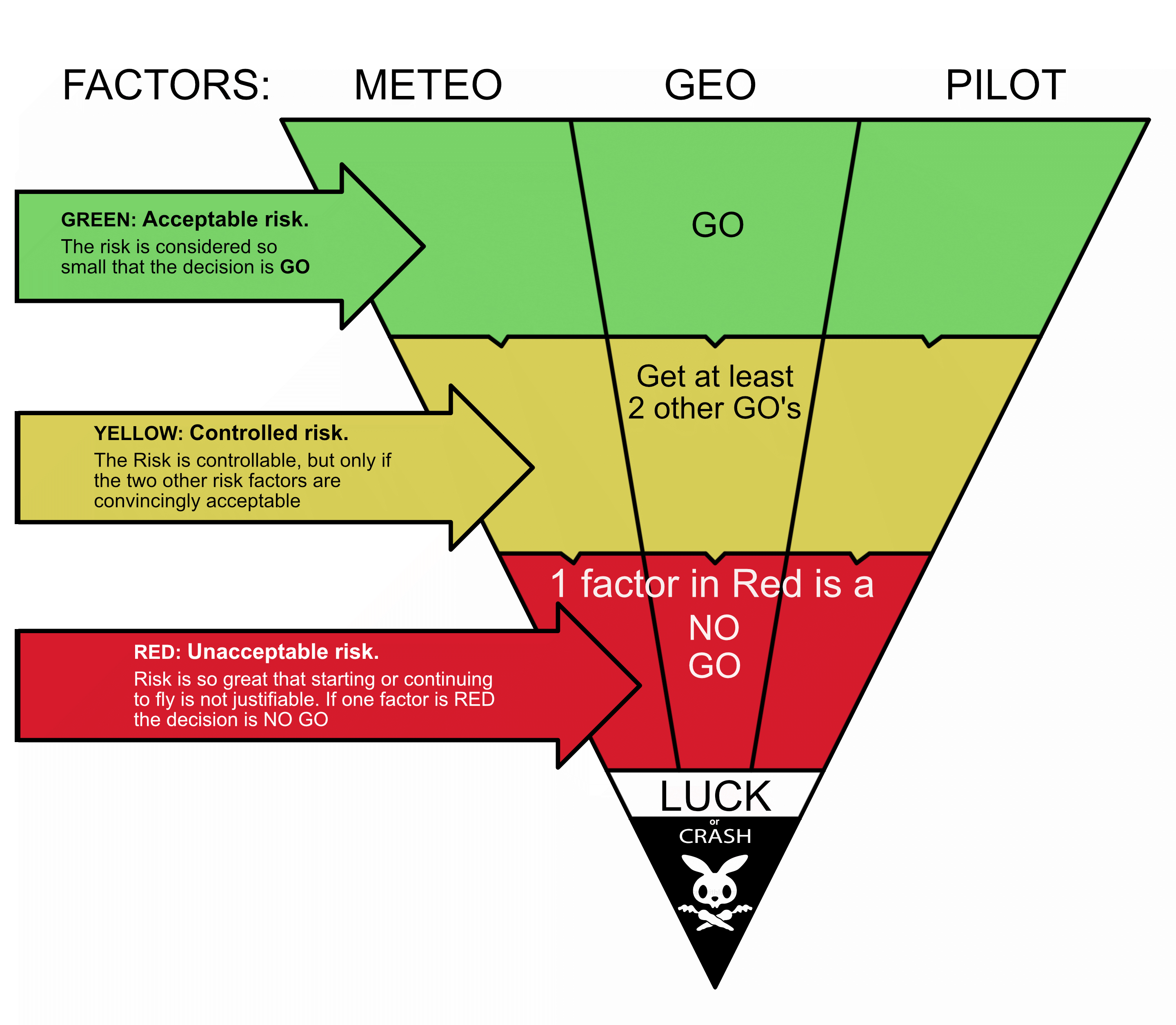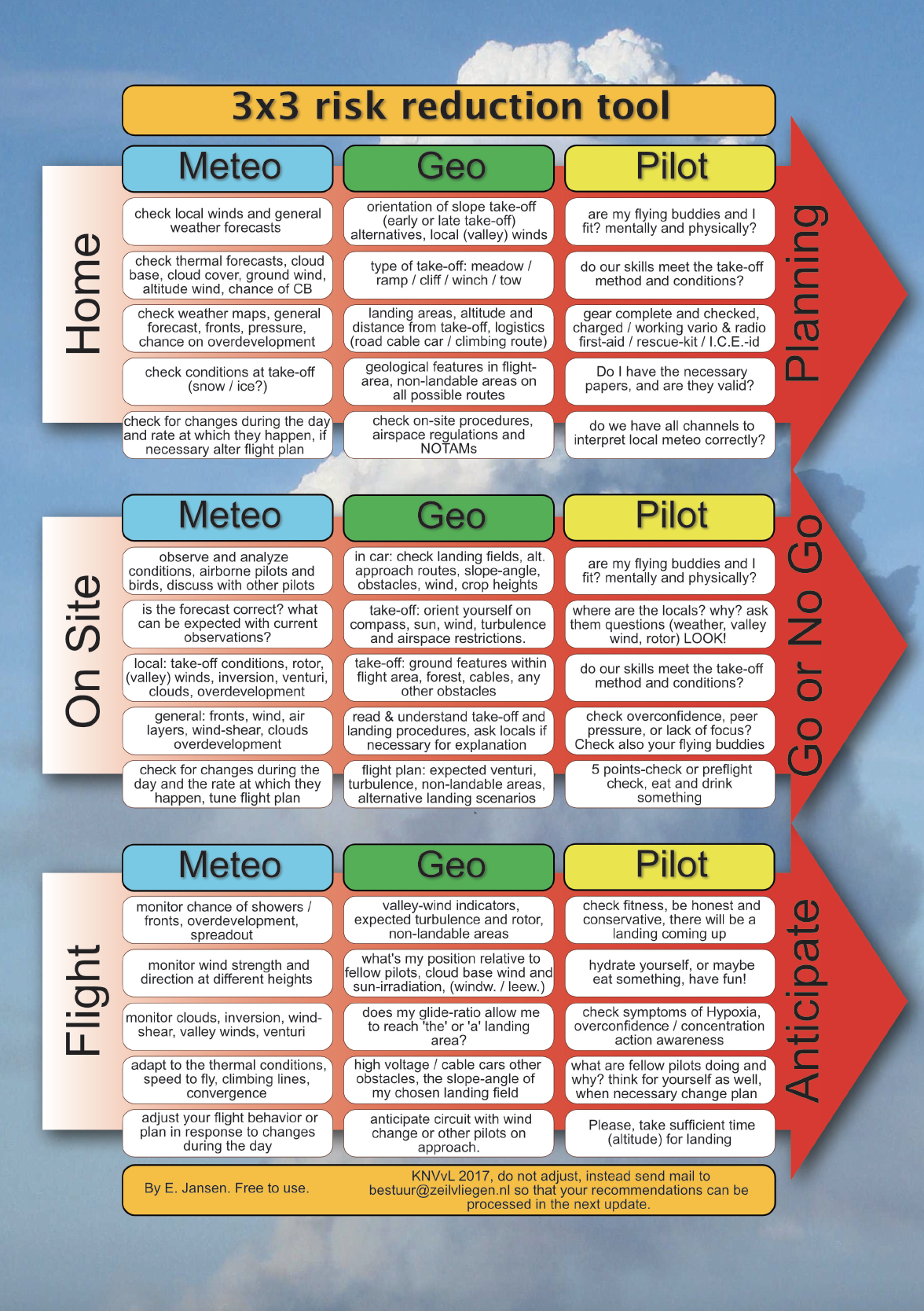By Emiel Jansen
Originally published in USHPA Pilot, May/June 2019
Are mountains dangerous? Of course not. They only pose a risk if we decide to turn the landscape into an airfield and engage in risky activities. The level of risk for you as a hang glider or paraglider pilot depends on your interaction with your environment. Because of the many factors involved, it is hard to make an objective analysis of risk without an objective measuring tool We present this tool: the 3x3 Risk Reduction.
Models for risk reduction are not new. Off-piste skiers and snowboarders use Werner Munter’s 3x3 method to assess avalanche danger. With this method, one always makes a choice in a step-by-step plan that leads to a
“Go” or “No Go.” The problem with our sport is that we do not have an “emergency exit” once we are in the air. Where an off-piste skier often can choose to descend a slope that has a different orientation or less steep terrain, we cannot land on a ridge or tree branch just to calm down and have a look at the risk-reduction model. But we are given important moments when choice is possible, before and during the flight. We re-wrote Munter’s model for para- and hang gliding, and I think it will help you recognize those moments of choice that will allow you to make an informed decision, once you are familiar with the system.

The 3X3 Tool
The model presents three sets of factors in three different phases. During the planning and execution of the flight, a distinction is made between the following three phases:
- Planning at home, with maps, area description, weather forecasts, YouTube and webcams
- Observation at the site, such as checking out landing spots and circumstances, reading the site rules
- Decisions during the flight, including the changing (weather) conditions and accessibility of landing sites.
At each of these three phases you evaluate the following three factors (3x3):
- Meteo, including aspects such as wind strength, wind direction, etc.
- Geo, including aspects such as landing-field obstructions, downwind terrain, etc.
- Pilot, including aspects such as health, peer pressure, competition pressure, etc.
Meteo consists of the expected weather conditions. You will not be surprised that the meteorological conditions, and their unpredictability, pose great risk in our sport. Think of an unexpected wind gradient during the landing, or a developing storm cloud on your XC route.
Using the tool: In phase 1, get information from the weather forecast at basecamp; in phase 2, view the situation from the start and landing spots; and in phase 3, keep an eye on the weather during the flight.
Geo concerns the condition of the terrain that changes per location and during flight. Analyze what possibilities and what dangers lie in wait. Imagine confronting a rotor, windy gaps with a lot of sink, or a sloping landing field. Visualize them, in all three phases.
Pilot refers not only to you, but also to the group you are traveling with, the locals you meet and your equipment. It would be wise to check each other, both physically and mentally. Again, you should think of the individuals in all three phases.
By consciously making a good decision regarding these three factors at three different phases (3x3), a pilot can prevent the risk of an incorrect assessment and, therefore, eliminate a dangerous situation. Phase 1, the preparation and creation of a plan, can be done in peace at home by immersing yourself in information about the flight area, by viewing weather forecasts and webcams and making plans with your travel group. You can learn to make the right decisions at the flight site and in the air by practicing a lot (and preferably together) in the real world, going out with schools, and discussing the situation with experienced pilots.

The Risk Filter
With the 3x3 tool, risks can be analyzed in a simple and organized manner. The pilot then has to make an assessment of whether his/her analysis leads to a Go or a No Go. The decision process is illustrated in the diagram, using the same three factors: Meteo, Geo and Pilot. For each factor, you can predict the risk by using the 3x3 tool. Ideally, all three factors will be located in the green area. If one is in red, a crash is lurking, with only luck serving as the safety-net to prevent it. An example: You bought a new, more advanced glider that you aren’t familiar with. As a result, the factor of Pilot is burdened with risks in the red wedge (new glider and upgraded performance). What can you do to reduce this risk? Consciously choose extra safety in the other factors of Meteo and Geo: Go to the safest flight spot for that day, and do not settle for less than ideal weather conditions.
So, in each of the three phases, consider all aspects of the three factors in the diagram.
Fly Fever
The reason we sometimes, consciously or un-consciously, take greater risks than are healthy for us is human nature. It is not fun to miss a nice flight because the circumstances seem a bit too “sporty,” especially when others take off and are high above you. It is also difficult for us to deviate from an existing plan; this is called ballistic thinking. After an hour-long journey to the starting place, the urge to fly is great. After all, your effort must be rewarded, right? If you are part of a group, the risk for the group also depends on the behavior and attitude of the group members (social interaction and group behavior). Inexperienced pilots often seem to lean on the knowledge, decisions, and actions of the most experienced pilot of the group. So the experienced pilot, whether he likes it or not, sets the example: If he feels pressured to make a socially desirable decision in dubious circumstances, he may increase the risk for less experienced group members. As long as you are still on the ground with your flying buddies, you can jointly recite the 3x3 tool and help each other make a democratic “Go” or “No Go” decision. Once you are in the air, you have to do it yourself.
Risk is Personal
Many pilots faithfully do their checks and have their own method for risk management. Yet quite a lot of accidents happen, not only among students, but also among experienced pilots. That developing black sucking storm cloud makes no distinction between the seasoned overland pilot that you are (or think you are) and the clumsy pilot who keeps on getting in your way at takeoff. The way in which you take responsibility for your own behavior determines your safety. Recognizing risk, making decisions, and acting on them is often made difficult by making incorrect observations and/or assessments, stress, and peer pressure. It is also possible that you have set the bar too high. In almost all air accidents, the pilot indicates afterwards that the accident could have been prevented if he or she had done something, not done something, or done something different. Experience, knowledge and expertise, and behavior and risk-appetite are all decisive factors. If you want to fly with minimal risk, you must learn to recognize and anticipate your personal risks and weaknesses. No method or checklist can ensure that you will fly safely 100% of the time. The 3x3 method presented here is a tool, but certainly not a sacred checklist.